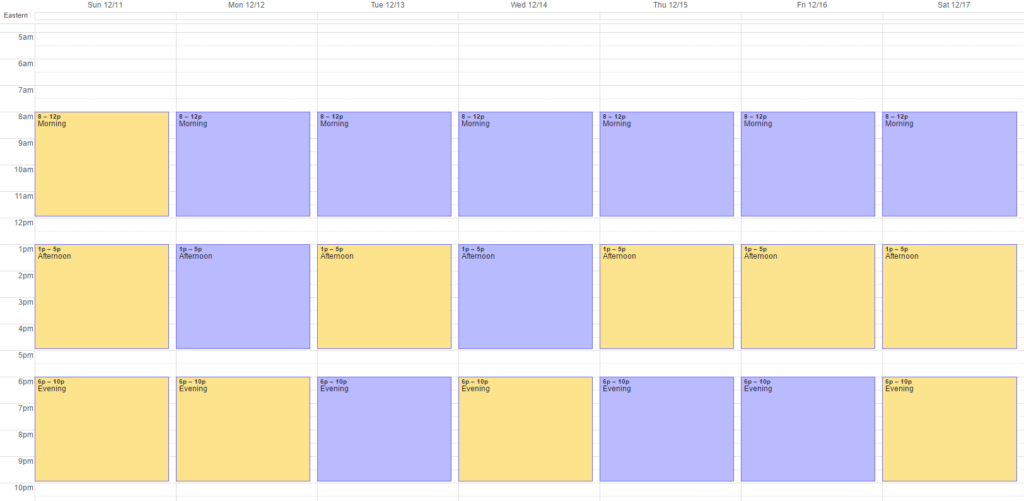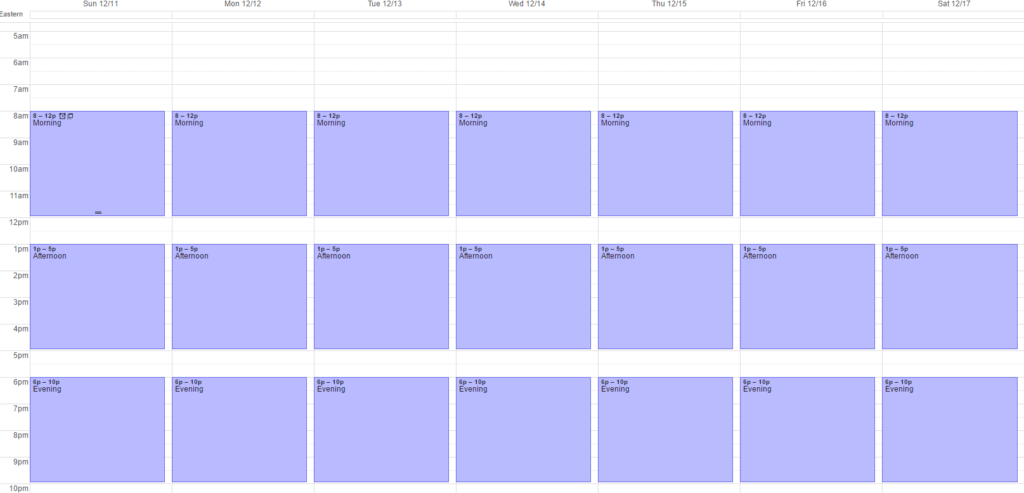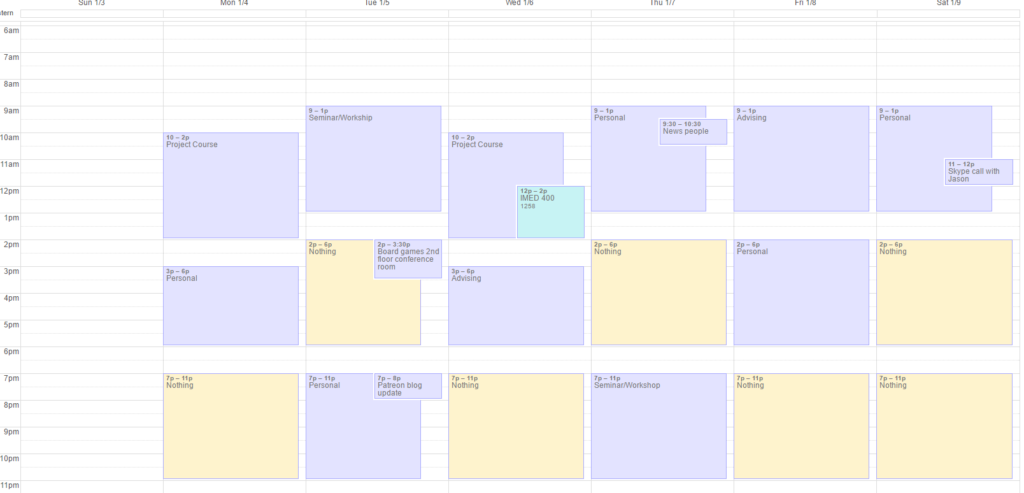It seems that Patreon redid how deactivated accounts are viewed, so I was able to get access to a bunch of my old posts! My “time management for sick people” post seemed to help a lot of folks back then, so I’ve salvaged and updated it.
Here’s a story about how my body betrayed me and I had to totally restructure how I managed my time. Come along for the ride! For some background, I used to be a highly efficient person when it comes to tackling the to-do list. I’d been an adherent to a modified version of GTD for years, and it enabled me to manage numerous projects at once and milk my free time for everything it was worth. I got very used to being extremely productive over the early part of my career.
From 2015-2017 I got deeply sick. My fibromyalgia was flaring up out of control, and at the time I was still trying to just push through it (stupid). I wasn’t able to operate at the productivity level that I’d been used to (and when I did try to operate “normally”, I ended up just making myself more sick).
In 2016 I did an academic residency at Harrisburg University, and the schedule was flexible enough that I was able to work out a time management system designed to focus on healing and get out of my bad “do all the things” habits. The method was designed with help from Jason Vandenberghe, and the goal was to adapt my schedule to my limitations at that time.
Specifically, it was designed to both allow myself room to heal AND to keep myself from overdoing things and taking on more responsibilities than I was capable of handling. The system worked out really well for me, and helped me get back on my feet.
If you are used to being a productive overachiever and have found yourself in a situation where you can’t juggle as much as you are used to (sick, depressed, injured, burnt-out) then perhaps this method will help you in the same way it helped me.
I called it “Block Scheduling” (which is funny to me because that’s what my high school scheduling method was called).
Caveat
Note that this experiment favors those who can get some flexibility in their schedule. It might be really good for indies or folks with a robust support network, but difficult if you are beholden to a rigid schedule. If you are working a 9-5, or maybe even several jobs just to make ends meet, and have limited external help, this probably won’t be of much use. Those circumstances are brutal and I don’t know how to help other than hope you can build a support network to help you. Possibly there are still some lessons that are applicable, but I don’t want this post to sound patronizing to those in an impossible situation.
If you are fortunate enough to have the ability to make a flexible schedule, perhaps with a partner or family or close friend network to support you on the financial side, this may work for you.
Step 1 – Sorting Priorities
Setting up the schedule is a multi-step process. First comes just getting a grasp on your current responsibilities and being honest about their importance and energy costs.
I first made a list of the things I was responsible for that semester. I wasn’t overly specific, but tried to catch the range from “stuff I was being paid for” to “personal stuff I want to do.” Eventually I ended up compressing the groups even further, but we’ll get to that. Once I had the list, I assigned them values in 2 categories: Importance and Difficulty
Importance means “how much will the world burn down if I don’t do this”
Difficulty means “how much energy does this consume to do”
Here’s what my final list ended up looking like
This is a part where you have to be extremely honest with yourself, and adhere to the definitions of importance and difficulty above. For example, even though my patreon and streams were extremely important to me personally, if I did suddenly stop doing them, it wouldn’t be a huge deal in the grand scheme of things (and in practice, it wasn’t! But at the time that was hard to see). No one is dependent on them in the same way that students were dependent on my role at the university, hence the low “importance” score. Similarly, I had to really be honest with myself about how much energy these responsibilities would consume in my weakened state at the time.
Step 2 – Culling and Condensing
After you have your list of priorities, take a look at them and make some calls about anything that needs to be cut. Big differences in importance vs difficulty can be red flags. I ended up taking a deep breath and cutting “Mastery Exercises” and “Work on Own Game.” “Patreon Streams” also took a back seat (any streams I did that first semester were generally more casual). “Find Doctors” (later expanded to include all health-related things) shot to the top of the list as priority number one.
I want to take a moment to point out how difficult this was for me. In my mind, my betterment as a game designer had always held the top priority spot when it came to anything I did. Being able to take a step outside of myself, look at those things and say “if I stop devoting time to this for a while, it really isn’t going to have that big of an impact.” It was hard, but it was honest.
Remember, this state probably isn’t forever. Even if you are chronically ill, the flare-up may subside. Perhaps your illness or condition is temporary, even though it feels like you’re stuck in a new normal forever. The purpose of this method is to set things up so that you can heal and keep from burning out.
I also condensed a few responsibilities. The seminar and workshop merged to become my seminar panels I did for the school. I took all the game design betterment stuff I’d cut and folded it with the health stuff to create the “Personal” category. This might seem counterintuitive to what I just said in the previous paragraph, but my logic here was that all those personally important responsibilities could live in this category as long as all health goals came before it.
Step 3 – Blocking in a Schedule
Here’s the fun part. You are now going to set up a schedule for a 2 week span of time following this step by step process:
1. Get a blank calendar, or set up part of a spreadsheet to represent a week. (I did this whole process in a spreadsheet first and then set up a calendar after) For every day of the week, denote 3 blocks: Morning, afternoon, evening. Something like this in a spreadsheet:
or this if you’re using a calendar (paper or otherwise)
NOTE that these blocks each have at least an hour break in between them. You won’t be scheduling anything in these gaps, those are for food or whatever. I started making my slots 4 hours long with an hour break in between, but after experimenting in the spring, I later ended up doing 3 hour blocks with 2 hour breaks (I was REALLY sick. This was the beginning of what became my standard mid-day recovery nap for years to come)
Now you have a blank calendar with 3 slots per day. If you’re thinking “I know what comes next, I will assign tasks to blocks,” SLOW DOWN. There’s another step first.
2. For each day, choose one block and pre-assign it to “Nothing.” During this block, you are not allowed to work on your responsibilities. You may putter around, maybe play some games or read, maybe play with your cat, maybe take a nap (I used lots of my nothing slots for this, also long baths). Maybe hanging out with friends goes here as long as it’s casual in nature. This is not one small break a day, this is an ENTIRE slot per day devoted to turning your brain off. Take this step seriously.
You might want to experiment with which slot to devote it to. I tried out some Nothings in the evening and some in the afternoon (I had the luxury of a flexible enough schedule to allow me to do this)

Important sub-step: AT LEAST one day should be ONLY nothing slots. I picked Sundays for this, and reserved 2 Nothing slots on Saturdays.
A note on this. For me the “nothing” blocks meant shutting down my brain because of the sickness I was healing from. Really it can be anything that recharges your batteries and steps away from being goal-oriented. This may help for 9-5 people who may only have evening slots open to them.
Now you should have ~11 available slots per week, and 2 weeks to fill in.
3. Go through each of the free blocks and assign it to ONE of your priorities. Only one can go in there. Be honest about how much time a week you think you will need to put into that responsibility. Try to line up related responsibilities to hard calendar entries (meetings, etc). You can always adjust later.
Here’s a sample from the actual calendar that I was using at the beginning of 2016
Step 4 – THE MOST IMPORTANT STEP
Now you have 2 weeks blocked out, and you’re ready to do a test run. Just go about your days and adhere to the schedule, but here is the MOST important thing:
If you are working on responsibility 1 in one block, and finish after only an hour, you are NOT ALLOWED to work on responsibilities 2, 3, 4, or whatever to fill up the rest of that slot. NOT ALLOWED. You already have time allotted to those responsibilities in another slot, you work on them during their allotted slots.
This was one of the most challenging parts for me, but also key to the whole thing working. You see, I was used to filling up free time with other stuff on my Next Actions list. Just pop the next one off the list and fill up the rest of the time. Maybe that’s fine and well when you are operating at > 80%, but when you are sick it just contributes to potentially making you even sicker.
Okay, so what do you do in the rest of the 3 hours of your morning block when you end up finishing responsibility 1 early? Just use the time for other things that come up. Deal with emails that have come in, read an interesting article someone sent out, so on and so forth. There’s always “stuff that comes up” that you can deal with in the moment, otherwise just chill.
Step 5 – Dealing with New Responsibilities
After a two week trial to see if this scheduling method will work for you, and if you decide that it does, you then just plot out your weeks as you go and follow the schedule. But what do you do if a new opportunity presents itself? Maybe you get invited to do a talk, or to be on a podcast. Maybe someone asks you for feedback on their game. (Remember that a lot of stuff you do “just to help” someone out still counts as a responsibility and uses up energy. This can be as simple as answering an email asking for advice)
Just give a guess for how much time that thing might take to prepare and see if you can swap out one of your other slots for working on it.
And I don’t mean the “Nothing” slots, those remain untouched.
I looked at my schedule and thought “Could I switch out an Advising slot for a couple of weeks and use that time to prepare my talk, without it negatively influencing my Advising responsibilities? Could I use one of my Personal slots to give feedback and advice since my doctor stuff is all squared away now?”
If the answer is “no” then you SAY NO TO THE THING. Even if you really want to do it, even if you think it is important that you do it, if you can’t afford to sacrifice some slots then you turn it down. Remember, we are healing here, and trying to take advantage of all opportunities while you are sick and in recovery is a good way to make you sicker and keep you in recovery longer.
Say no.
SAY.
NO.
This may be the hardest thing for you, but you HAVE to do it. You have to get good at saying no.
Delegation can help out here. Maybe you can’t do that talk but perhaps you can recommend someone else who would be a good fit?
If you need some time to really process a new opportunity and figure it out, you can tell the person “I would love to, but I have to check with the boss first.” You can be your own boss in this case (or consult with close friends), the point is to make you comfortable with giving it a little bit of time.
Conclusion
I used the block scheduling rigorously in the Spring of 2016, and then an adjusted version in the Summer. By Fall my health was considerably back in order, despite some lingering fatigue issues, so I began to loosen up and start moving back to my usual time management structure. However, following the block scheduling taught me a few things
- It helped me be honest with myself about how much time and energy certain things really take (especially those little favors that I want to do just because I want to help people). This was hugely important in subsequent years to help me make judgement calls on what to take on.
- It taught me temperance. I am more wary of the projects I want to take on now, and much better about letting go of an old responsibility to make room for a new one, rather than just trying to stack them all on at once. After a few years, it’s become easy to let go of things.
- It gave me the space to get comfortable with how my body operates in this weakened state. As I mentioned with the recovery naps,, some of the things I tried became permanent fixtures in my life. I’ve learned when my brain starts to shut down in the evenings and how to structure my day around it. I’ve learned I can only do one “thing” a day, so if I go kayaking in the morning, that is it for the day.
- It reassured me that though I may have other low health times in the future, that they don’t have to be “forever.” In hindsight I only did this modified time management for like 2/3 of one year, but in the beginning I worried about it being the new forever. On the other hand, I’m not back to the way I was before, because that way was unsustainable. I’ve learned to be efficient within my means, and I’m very happy with how things have been going.
If you are suffering from illness (mental or physical) or burnout, and you have the flexibility in your life, consider giving this method a try! It won’t be the right fit for everyone, and your mileage may vary, but it could give you some insights into how you can structure your life around your most immediate needs (healing).




